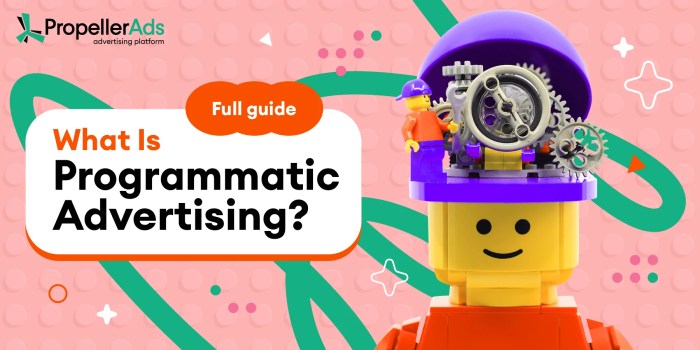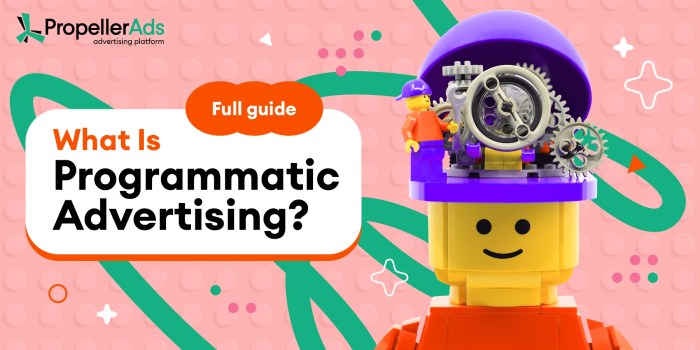The fundamentals of programmatic display advertising sets the stage for understanding how digital ads are bought and sold. This involves a lot more than just traditional banner ads. It explores the intricacies of real-time bidding, programmatic direct, and how ad exchanges and demand-side platforms (DSPs) power the entire process. We’ll also cover essential aspects like targeting, ad creative, measurement, and even the crucial topic of ad fraud.
This comprehensive guide will equip you with the foundational knowledge to navigate the dynamic world of programmatic advertising.
From campaign setup and targeting to ad creation and optimization, this overview explores the critical stages of a typical programmatic display campaign. Understanding these steps is essential for advertisers seeking to maximize their return on investment in the digital space. We’ll delve into the different targeting methods, ad creative best practices, and the crucial role of measurement in optimizing campaigns for success.
Introduction to Programmatic Display Advertising
Programmatic display advertising is revolutionizing how brands connect with audiences online. Instead of relying on manual, often time-consuming, ad placement strategies, programmatic advertising uses automated systems to buy and sell digital display ads in real-time. This efficiency and precision significantly improve campaign performance and return on investment.This automated approach allows for dynamic targeting, optimizing ad delivery based on real-time data, and providing unparalleled flexibility for advertisers to adapt to changing market conditions.
The result is more effective campaigns that reach the right audience at the right time, driving better engagement and conversion rates.
Key Differences from Traditional Display Advertising
Traditional display advertising often involves manually placing ads on websites, relying on pre-negotiated deals. Programmatic display, on the other hand, leverages sophisticated algorithms to buy ad space dynamically. This difference translates to greater efficiency, speed, and targeting capabilities. Traditional methods are typically less adaptable to real-time data and market shifts.
Programmatic display advertising is all about automating ad buying, right? It’s about using technology to target specific audiences and get the most out of your ad spend. But what happens when a company like mazuma, turning a commodity service into a brand , takes this to the next level? They’re demonstrating that the fundamentals of programmatic display advertising are powerful, but they need a strong brand identity to truly connect with customers.
Ultimately, the fundamentals of programmatic display advertising are about more than just the tech; it’s about effective marketing strategies that work.
Types of Programmatic Display Advertising
Programmatic display advertising encompasses several methods, each with unique characteristics. Real-time bidding (RTB) is the most prevalent, where advertisers bid in real-time for ad impressions on a per-impression basis. Programmatic direct (PD) is another model, where advertisers work directly with publishers to secure ad inventory at predetermined rates.
Benefits for Advertisers
Programmatic display advertising offers numerous benefits for advertisers. Increased efficiency and speed are major advantages, allowing for faster campaign implementation and adjustments. Advanced targeting capabilities mean advertisers can precisely reach their ideal customer segments, minimizing wasted ad spend and maximizing return on investment.
Programmatic display advertising is all about using automated systems to buy ad space. But, a key challenge for smaller businesses is mastering SEO, which often feels like a daunting task. For instance, understanding the intricacies of nine reasons SEO is hard for small businesses can impact your overall digital marketing strategy. Ultimately, grasping these fundamentals is crucial for success in today’s competitive online marketplace.
Role of Ad Exchanges and DSPs
Ad exchanges are platforms where ad inventory from various publishers is aggregated and made available for purchase. Demand-side platforms (DSPs) are tools used by advertisers to manage their programmatic campaigns. DSPs connect to ad exchanges, enabling advertisers to bid on ad impressions and manage their campaigns effectively. The exchange and DSP work in tandem to optimize ad delivery and maximize campaign performance.
Understanding the fundamentals of programmatic display advertising is key for any business looking to get the most out of their online presence. Knowing how much local small businesses are investing in social media marketing is crucial to tailoring your programmatic strategies effectively. For instance, insights into spending habits, like those found in this article on how much do local small businesses spend on social media , can help you target the right audience with the right message at the right time.
This data-driven approach is vital for optimizing your programmatic display campaigns for maximum ROI.
Steps in a Typical Programmatic Display Campaign
Understanding the steps involved in a programmatic campaign is crucial for successful implementation. This structured approach ensures that every stage is optimized for desired results.
| Step | Description |
|---|---|
| 1. Campaign Setup | Defining campaign goals, budget, and target audience. This initial setup establishes the framework for the entire campaign. |
| 2. Targeting Definition | Identifying specific demographics, interests, and behaviors of the target audience. Precise targeting is essential for maximizing ad relevance and engagement. |
| 3. Bidding Strategy | Setting bidding parameters, such as maximum bid amounts and target cost-per-acquisition (CPA) or cost-per-click (CPC). A well-defined bidding strategy ensures optimal ad spend. |
| 4. Ad Creation | Developing engaging and visually appealing ads that align with the campaign’s objectives. Ad creation plays a crucial role in capturing attention and driving conversions. |
| 5. Campaign Monitoring | Tracking key metrics like impressions, clicks, conversions, and cost-per-acquisition (CPA). Continuous monitoring allows for adjustments and optimizations to improve campaign performance. |
Targeting and Audience Segmentation
Programmatic display advertising thrives on precision. Knowing your audience isn’t just a good idea; it’s essential for maximizing campaign ROI. Effective targeting, coupled with insightful audience segmentation, allows advertisers to connect with the right people at the right time, leading to increased engagement and conversions. This crucial aspect of programmatic goes beyond simple demographics and delves into the intricate details of user behavior and preferences.The ability to pinpoint specific segments of the online population, and then tailor messages to resonate with those individuals, is the cornerstone of successful programmatic campaigns.
This precision targeting minimizes wasted ad spend by ensuring that your ads are seen by individuals most likely to be interested in your product or service. This directly translates to improved campaign performance, ultimately achieving desired business outcomes.
Targeting Options in Programmatic Display
Programmatic display advertising offers a plethora of targeting options. These options extend far beyond simple demographics, allowing for highly specific and nuanced audience selection. The variety of methods enables advertisers to refine their campaigns to reach the most receptive users, resulting in improved engagement and conversion rates.
- Demographic Targeting: This method uses readily available data on age, gender, location, income, and education to identify potential customers. Demographic data is often readily accessible, making it a quick and easy method to target a broad audience segment.
- Behavioral Targeting: This approach leverages user activity on websites and apps to understand their interests and preferences. This targeting method involves tracking browsing history, website visits, and app usage to understand user behavior and create highly targeted segments.
- Contextual Targeting: Contextual targeting focuses on displaying ads based on the content of the webpage or app a user is viewing. This method matches ads to relevant content, increasing the likelihood of user engagement and improving ad relevance.
- Interest-Based Targeting: This targeting strategy uses user browsing history, website visits, and app usage to identify user interests. The ads are shown to users who demonstrate an interest in similar topics.
- Retargeting: This strategy targets users who have previously interacted with a brand’s website or ads. Retargeting aims to re-engage potential customers who have shown initial interest but haven’t yet converted.
- Custom Audiences: This method allows advertisers to upload their own customer data (e.g., email lists, CRM data) to target similar audiences online. This approach allows for highly specific targeting by identifying individuals who exhibit traits similar to existing customers.
Effective Audience Segmentation
Effective audience segmentation is crucial for optimal campaign performance. A segmented approach allows for more focused and precise targeting, leading to better campaign results. It is a key element of any successful programmatic strategy. It’s about understanding the nuances of your target audience and tailoring your message accordingly.
- Defining Clear Objectives: Before segmenting audiences, establish clear campaign objectives. Understanding the desired outcome (e.g., brand awareness, lead generation, sales) will guide the segmentation process. This ensures the segmentation strategy directly aligns with the overarching campaign goals.
- Identifying Key Traits: Identify the key traits, interests, behaviors, and demographics that distinguish different segments of your target audience. Understanding these nuances will inform the creation of precise segments.
- Utilizing Data Sources: Leverage a variety of data sources, including website analytics, CRM data, and third-party data providers, to create comprehensive audience profiles. This will enhance the depth and accuracy of the audience segments.
Data’s Role in Programmatic Targeting
Data plays a pivotal role in programmatic targeting. It enables advertisers to understand user behavior, preferences, and interests, leading to more effective campaigns. Sophisticated algorithms use this data to connect advertisers with the right audience at the right time, maximizing campaign effectiveness.
- Data Collection and Analysis: Collect and analyze data from various sources to gain insights into user behavior and preferences. This data will inform the creation of targeted segments.
- Data Privacy and Compliance: Advertisers must adhere to data privacy regulations (e.g., GDPR, CCPA) to ensure ethical and compliant data collection and usage. This is paramount to maintain trust and credibility with users.
Comparison of Targeting Methods
Different targeting methods offer varying advantages and disadvantages. A strategic understanding of each method is essential for selecting the most appropriate approach for a particular campaign.
Ad Creative and Design

Compelling ad creatives are the lifeblood of successful programmatic display campaigns. They are the first and often the most critical point of contact between your brand and potential customers. Without captivating visuals and concise messaging, your ad spend can quickly become a wasted investment. A well-designed ad captures attention, conveys your brand message effectively, and ultimately drives conversions.Effective ad creatives go beyond simply showcasing your product or service.
They need to resonate with the target audience, create a desire for engagement, and guide the viewer towards the desired action. This requires meticulous planning and understanding of the platform and audience specificities. Successful programmatic display advertising relies heavily on the quality of the ad creative, making its design and optimization crucial for maximizing ROI.
Importance of Compelling Ad Creatives
Strong ad creatives are paramount in programmatic display advertising. They are the first impression and often the decisive factor in whether a user engages with an ad or scrolls past. Captivating visuals and clear messaging directly impact click-through rates (CTR) and ultimately, conversions. Poorly designed ads can result in wasted ad spend and decreased overall campaign performance.
Best Practices for Designing Effective Ads
The best practices for creating effective programmatic ads vary depending on the platform and the target audience. For example, a short, engaging video ad might work best on platforms like YouTube, while a concise image-based ad might be more suitable for news websites. The choice of format, color scheme, and overall design should be carefully considered to resonate with the specific audience on each platform.
Examples of Successful Ad Formats
Numerous successful ad formats exist in the programmatic display space. One highly effective format is the animated GIF, which can effectively convey a message in a short and engaging manner. Video ads, particularly short-form, are also extremely successful, often captivating attention with dynamic visuals. Carousel ads, allowing multiple images or videos, offer a chance to showcase more product options.
Another example is the use of interactive elements, such as quizzes or polls, which can encourage user engagement. The key is to select a format that best complements your brand message and target audience.
Optimizing Ad Creatives for Different Devices
Programmatic ads need to be optimized for various devices. Desktop ads often benefit from larger visuals and more detailed information. Mobile ads, on the other hand, should be designed with a focus on smaller screens and potentially interactive elements. A responsive design, ensuring ads adapt seamlessly to different screen sizes, is critical. Images and videos should load quickly, and the ad should be easy to interact with on touchscreens.
Significance of A/B Testing for Ad Creative Optimization
A/B testing is an indispensable tool for optimizing ad creatives. By testing different versions of ads (variations in visuals, messaging, or calls to action), you can identify which elements resonate most strongly with your target audience. This data-driven approach allows you to fine-tune your campaigns for maximum effectiveness and significantly improves conversion rates. Constantly monitoring and adjusting based on A/B testing results is key to maintaining campaign performance.
Key Elements of an Effective Ad Creative
- High-quality visuals: Visually appealing imagery or video is crucial for grabbing attention and conveying your message effectively. High-resolution images and smooth video playback contribute significantly to user engagement.
- Clear call to action: A clear and concise call to action (CTA) is essential for guiding users towards the desired action, whether it’s making a purchase, visiting a website, or signing up for a newsletter. A strong CTA is often visually highlighted to ensure it’s easily noticed.
- Relevant messaging: The message should be relevant to the target audience and aligned with your brand’s overall marketing strategy. Relevant messaging is more likely to connect with potential customers and create a meaningful interaction.
- Appropriate ad size: The ad size should be appropriate for the platform and device. For instance, a banner ad might be suitable for a website, while a video ad could be better for a social media platform. Ensuring your ad size aligns with the platform’s best practices and design guidelines is critical.
- Brand consistency: Ad creatives should maintain consistent branding elements, such as logos, colors, and fonts, to reinforce brand recognition and reinforce brand identity. Consistency across all ad creatives builds brand awareness and recognition.
Measurement and Optimization
Programmatic display advertising relies heavily on data-driven decision making. Effective measurement and optimization are crucial for maximizing campaign ROI and achieving desired outcomes. Understanding key performance indicators (KPIs), analyzing campaign data, and employing real-time monitoring are vital components of a successful programmatic strategy. This section delves into the essential metrics, analysis techniques, and optimization strategies for programmatic display campaigns.
Key Performance Indicators (KPIs), The fundamentals of programmatic display advertising
Programmatic display campaigns utilize a variety of KPIs to gauge performance. These metrics provide insights into campaign effectiveness across different stages, from audience reach to conversion rates. Common KPIs include:
- Impressions: The number of times an ad was displayed to users. This metric provides a basic understanding of ad visibility and potential reach.
- Clicks: The number of times users clicked on the displayed ad. This measures user engagement with the ad and their interest in the advertised product or service.
- Click-Through Rate (CTR): The percentage of impressions that resulted in a click. CTR is a crucial metric for evaluating ad relevance and attractiveness. A higher CTR suggests a more compelling ad.
- Conversions: The number of desired actions taken by users after clicking on the ad, such as making a purchase, filling out a form, or signing up for a newsletter. Conversions are a key indicator of campaign effectiveness in driving desired outcomes.
- Cost Per Click (CPC): The cost incurred for each click on the ad. This metric helps understand the efficiency of spending and optimize budget allocation.
- Cost Per Mille (CPM): The cost of 1,000 impressions. This metric is valuable for understanding the cost-effectiveness of reaching a large audience.
- Viewability: The percentage of impressions that were fully visible to users for a predetermined amount of time. This metric is important for ensuring ad effectiveness and avoiding wasted impressions.
Tracking and Analyzing Campaign Data
Effective tracking and analysis of campaign data are essential for identifying trends and patterns that inform optimization strategies. Tools such as Google Analytics, Adobe Analytics, and proprietary platforms offer extensive capabilities for data collection, visualization, and reporting.
- Data Segmentation: Analyzing data by demographics, interests, behaviors, and other segments can provide valuable insights into which groups are most responsive to the campaign.
- A/B Testing: Testing different ad creatives, targeting parameters, or bidding strategies can identify the most effective approaches.
- Attribution Modeling: Determining the specific touchpoints in the customer journey that contributed to conversions is vital for understanding the true impact of the campaign.
Real-Time Campaign Monitoring and Analysis
Real-time monitoring and analysis are critical for adapting campaigns to immediate performance fluctuations. This allows for swift adjustments to improve campaign effectiveness.
- Real-Time Reporting: Platforms provide real-time data dashboards and alerts to monitor key performance indicators. These insights facilitate rapid adjustments based on emerging trends.
- Automated Adjustments: Advanced programmatic platforms allow for automated adjustments to bids, targeting, or creative based on real-time data. This enables dynamic optimization.
Optimization Strategies
Data insights enable informed decisions to optimize campaign performance.
- Targeting Refinement: Refining targeting parameters based on data can improve campaign efficiency by focusing on the most receptive audiences.
- Creative Optimization: A/B testing different ad creatives can improve CTR and conversion rates. Testing various ad formats, visuals, and calls to action can yield optimal results.
- Bidding Strategy Adjustments: Adjusting bidding strategies based on performance data can optimize budget allocation and improve conversion rates.
Comparison of Analytics Tools
Several tools are available for programmatic display advertising analytics. Each platform offers specific features and capabilities.
| Tool | Strengths | Weaknesses |
|---|---|---|
| Google Analytics | Extensive data collection and reporting capabilities, strong integration with other Google services | May not offer advanced programmatic features compared to specialized platforms |
| Adobe Analytics | Comprehensive analytics capabilities, deep data visualization, strong integration with Adobe ecosystem | Can be more complex to set up and use compared to Google Analytics |
| Proprietary Programmatic Platforms | Tailored metrics and reporting, advanced targeting and optimization features | Limited integration with other tools, potentially higher cost |
Flowchart of Programmatic Display Campaign Optimization
[A flowchart illustrating the process of optimizing a programmatic display campaign would be included here. It would visually depict the steps from data collection to campaign adjustments, but cannot be created textually]
Ad Fraud and Security
Programmatic display advertising offers incredible efficiency, but it’s not without its vulnerabilities. Ad fraud, a significant threat to the entire ecosystem, erodes trust and can dramatically impact advertiser budgets and campaign effectiveness. Understanding the various forms of fraud and the best practices to combat it is crucial for any marketer leveraging programmatic channels.
Types of Ad Fraud
Ad fraud encompasses a wide range of deceptive activities designed to inflate ad impressions, clicks, or conversions. These tactics aim to deceive advertisers into paying for non-existent or invalid interactions. Common types include:
- Click Fraud: This involves generating fake clicks on ads, often through automated bots or fraudulent networks. Advertisers pay for clicks that did not result in a legitimate user interaction.
- Impression Fraud: This tactic involves generating fake impressions, often through bots that simulate user activity on a website or app without genuine interest. Advertisers pay for impressions that were never actually seen by real users.
- Traffic Fraud: This involves manipulating the traffic data to make it appear higher than it actually is. This can be done by inflating the number of visitors to a website or app.
- Fake Account Fraud: Creating fake accounts and profiles to generate impressions or clicks. This is a more sophisticated method that can be harder to detect.
- Invalid Traffic (IVT): A broad category encompassing various fraudulent activities designed to manipulate ad metrics, ultimately leading to wasted ad spend.
Risks for Advertisers
Ad fraud poses several serious risks for advertisers. The most significant is the misallocation of marketing budgets. Paying for fraudulent impressions or clicks directly impacts the return on investment (ROI) of ad campaigns. It also compromises the accuracy of campaign performance data. Advertisers may be presented with inflated metrics that fail to reflect genuine engagement.
This can lead to inaccurate conclusions about campaign performance and adjustments to the campaign. Finally, ad fraud can damage brand reputation, eroding trust in the entire ecosystem if not addressed properly.
Mitigation Measures
Implementing robust strategies to mitigate ad fraud is essential for advertisers. These strategies include:
- Using Fraud Detection Tools: Implementing robust ad fraud detection tools is a proactive measure. These tools analyze traffic patterns and identify suspicious activity. Some solutions employ machine learning algorithms to learn and adapt to new patterns of fraud.
- Strict Ad Quality Standards: Advertisers should insist on strict ad quality standards from their ad platforms. This involves evaluating the platforms’ policies and practices to identify their methods for maintaining a safe and clean environment.
- Working with Reputable Ad Platforms: Partnering with ad platforms that prioritize fraud prevention and have proven track records of combating ad fraud is crucial. Their technological resources, dedicated teams, and industry reputation are key factors to consider. These platforms often invest heavily in fraud detection technologies and constantly update their systems to keep pace with emerging threats.
- Utilizing Data-Driven Approaches: Employing data analytics to identify anomalies in ad performance and detect potential fraud is another critical component. Analyzing data on traffic sources, user behavior, and campaign metrics can highlight patterns suggestive of fraud.
Security Best Practices
Maintaining a secure programmatic advertising environment requires a multi-faceted approach. Security best practices for programmatic campaigns include:
- Regularly Review and Update Campaign Settings: Advertisers should periodically review their campaign settings and adjust them based on real-time insights to prevent any possible fraudulent activities. Regular monitoring is key for catching suspicious behavior early on.
- Employing Robust Filtering Mechanisms: Using advanced filtering mechanisms to block potentially fraudulent traffic sources can significantly reduce the risk of ad fraud. Platforms that incorporate robust filtering capabilities are critical for mitigating ad fraud.
- Adherence to Industry Best Practices: Advertisers should stay updated on industry best practices for programmatic advertising, including fraud prevention strategies. Regular training and staying current with evolving tactics are essential for maintaining security.
- Implementing Secure Authentication: Implementing strong authentication measures for accounts and campaigns can help prevent unauthorized access and manipulation of campaign data. Strong passwords and multi-factor authentication are critical.
The Future of Programmatic Display Advertising: The Fundamentals Of Programmatic Display Advertising
Programmatic display advertising is rapidly evolving, driven by advancements in technology and a growing need for more sophisticated targeting and optimization. This evolution promises both exciting opportunities and considerable challenges for advertisers and publishers alike. The future landscape will be shaped by the integration of artificial intelligence, the rise of new data sources, and the continuous quest for enhanced user experiences.The industry is transitioning from a focus on basic targeting to a more nuanced understanding of individual user behavior and preferences.
This shift necessitates a deeper understanding of data privacy, ethical considerations, and the responsibility that comes with manipulating user experiences. This evolving ecosystem is poised to reshape how brands interact with their audiences.
Emerging Trends and Technologies
The programmatic display landscape is constantly being reshaped by innovative technologies. Real-time bidding (RTB) continues to be a cornerstone, but advancements in automation and machine learning are leading to more sophisticated bidding strategies and more accurate audience targeting. This leads to more personalized and relevant ad experiences. Beyond RTB, other technologies like predictive modeling and AI-powered creative optimization are transforming how ads are designed and delivered.
Impact of Artificial Intelligence and Machine Learning
AI and machine learning are revolutionizing programmatic display. These technologies enable more accurate predictions of user behavior, allowing for highly targeted advertising campaigns. For example, AI algorithms can analyze vast amounts of data to identify patterns and preferences, enabling the creation of highly personalized ad experiences. This personalization enhances the effectiveness of campaigns by ensuring that ads are shown to the most receptive audiences.
Machine learning is also crucial for optimizing ad campaigns in real-time, adjusting bids and targeting based on performance data.
Predictions about Future Development
Programmatic display advertising is expected to continue its growth trajectory, driven by increasing adoption of automation, advanced targeting, and more sophisticated measurement tools. We can expect a greater emphasis on contextual targeting, leveraging information about the content surrounding an ad to ensure relevance. For instance, ads related to gardening might be more relevant on a website about home improvement.
The focus will also be on ensuring user privacy and data security, with greater transparency and control for consumers.
Potential of New Technologies for Enhanced Targeting and Optimization
New technologies are unlocking greater potential for enhancing targeting and optimization in programmatic display. For example, the use of contextual intelligence allows for ad delivery based on the surrounding content, increasing relevance and engagement. Furthermore, advancements in understanding user intent and behavior through advanced analytics enable more effective audience segmentation and targeting. This is leading to improved campaign performance and higher return on investment (ROI).
Key Challenges and Opportunities for Programmatic Display
The future of programmatic display presents both significant challenges and opportunities. Maintaining data privacy and consumer trust will be crucial. This requires adherence to evolving regulations and ethical considerations. Another challenge is the need to combat ad fraud and ensure the integrity of the ecosystem. Opportunities lie in leveraging AI for creative optimization, enabling more personalized and engaging user experiences.
Furthermore, the development of new technologies like augmented reality (AR) and virtual reality (VR) presents exciting opportunities for interactive and immersive advertising experiences.
Final Conclusion

In conclusion, programmatic display advertising is a complex but rewarding field. Mastering the fundamentals—from targeting and creative design to measurement and security—is crucial for success. Understanding the nuances of real-time bidding, ad fraud mitigation, and emerging technologies will position you to leverage this powerful tool effectively. By grasping the concepts presented, you’ll be well-equipped to navigate the evolving landscape of digital advertising.






